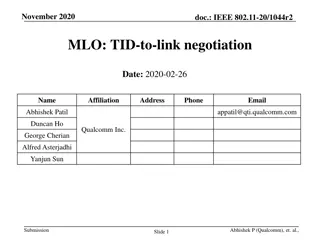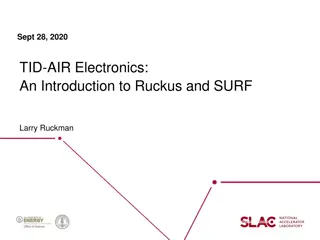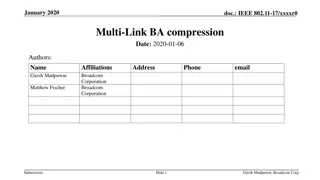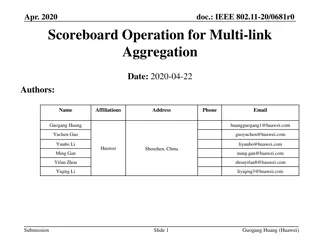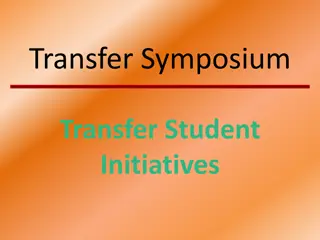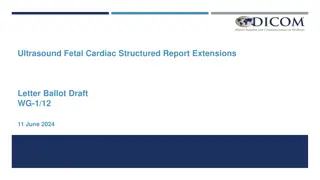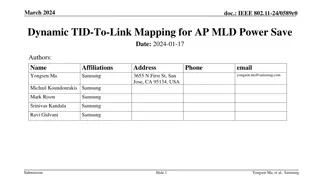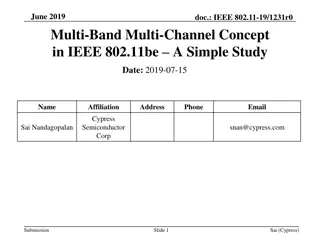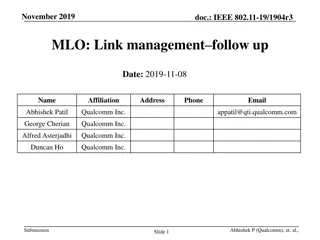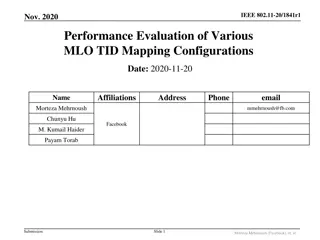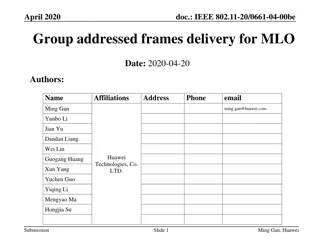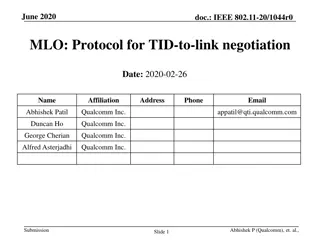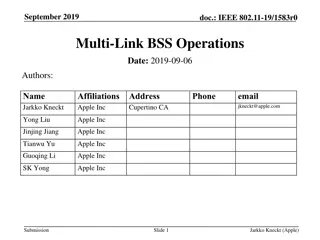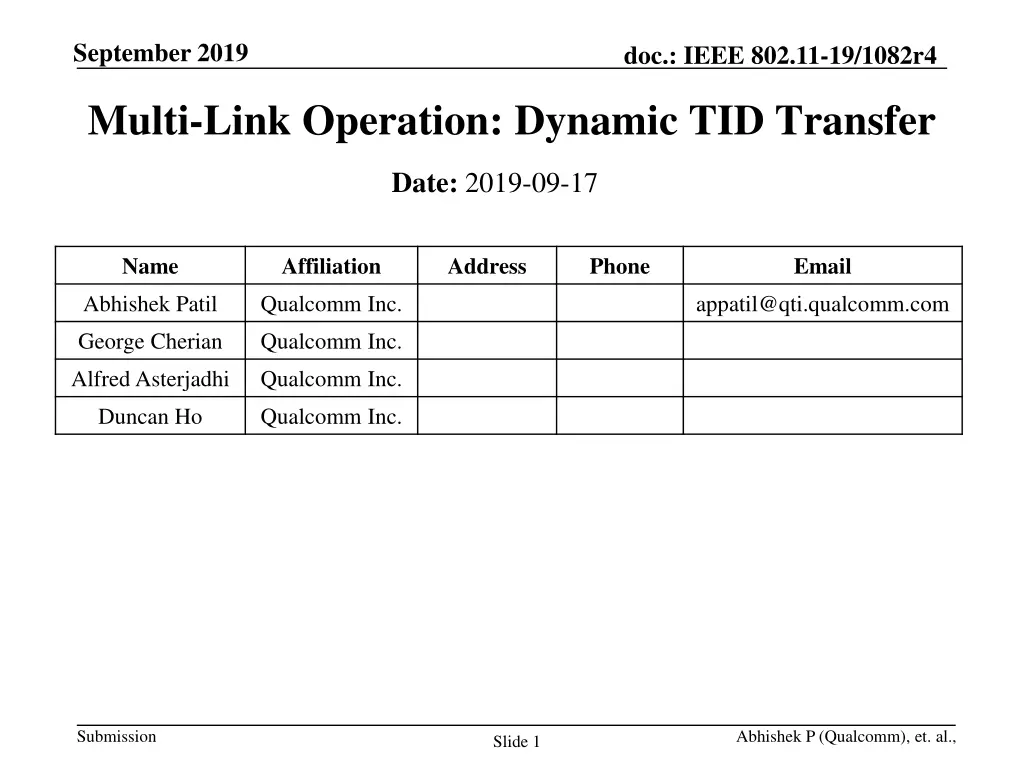
Supporting Dynamic TID Transfer in Multi-Link Operation
"Explore how the unified Multi-Link Operation (MLO) framework enables seamless transfer of TID between links based on specific conditions, such as load balancing or network congestion. This high-level design aims to enhance link switching capabilities for improved network performance and efficiency."
Download Presentation

Please find below an Image/Link to download the presentation.
The content on the website is provided AS IS for your information and personal use only. It may not be sold, licensed, or shared on other websites without obtaining consent from the author. If you encounter any issues during the download, it is possible that the publisher has removed the file from their server.
You are allowed to download the files provided on this website for personal or commercial use, subject to the condition that they are used lawfully. All files are the property of their respective owners.
The content on the website is provided AS IS for your information and personal use only. It may not be sold, licensed, or shared on other websites without obtaining consent from the author.
E N D
Presentation Transcript
September 2019 doc.: IEEE 802.11-19/1082r4 Multi-Link Operation: Dynamic TID Transfer Date: 2019-09-17 Name Affiliation Address Phone Email Abhishek Patil Qualcomm Inc. appatil@qti.qualcomm.com George Cherian Qualcomm Inc. Alfred Asterjadhi Qualcomm Inc. Duncan Ho Qualcomm Inc. Submission Abhishek P (Qualcomm), et. al., Slide 1
September 2019 doc.: IEEE 802.11-19/1082r4 Overview Multi-link operation (MLO) has been discussed in the past with the focus on packet-level aggregation [1] In this document, we discuss how the unified (MLO) framework can support dynamic transfer of a TID between links Submission Slide 2 Abhishek P (Qualcomm), et. al.,
September 2019 doc.: IEEE 802.11-19/1082r4 TID Link Switch DS MLO framework would need to have the ability to seamlessly move a TID from one link to another link based on a certain condition E.g., transferring a TID from a link on 2.4GHz to a link on 5GHz without requiring reassociation Packet-level agg MAC-SAP A STA STA Link on Link on WM WM A TID may be transferred for reasons such as load balancing or congestion E.g., 2.4GHz link is congested or becomes unavailable DS DS TID Link Switch MAC-SAP A MAC-SAP A Different from packet-level aggregation where both links are utilized for aggregation STA STA STA STA Link on Link on Link on Link on WM WM WM WM Submission Slide 3 Abhishek P (Qualcomm), et. al.,
September 2019 Example of unified MLO framework to support pkt-level / TID Link switching doc.: IEEE 802.11-19/1082r4 MAC-SAP-1 MAC-SAP-1 MAC-SAP-1 MAC Addr (M1) MAC Addr (M1) MAC Addr (M1) MLLE-1 MLLE-1 MLLE-1 Common Q Common Q Common Q Common BA session, SN/PN, security Common BA session, SN/PN, security Common BA session, SN/PN, security STA x STA y STA x STA y STA x STA y X STA p STA q STA p STA q STA p STA q Common Q Common Q Common Q Common BA session, SN/PN, security Common BA session, SN/PN, security Common BA session, SN/PN, security MLLE-2 MLLE-2 MLLE-2 MAC Addr (M3) MAC Addr (M3) MAC Addr (M3) MAC-SAP-2 MAC-SAP-2 MAC-SAP-2 Dynamic TID Link Switch Packet-level Aggregation Submission Slide 4 Abhishek P (Qualcomm), et. al.,
September 2019 doc.: IEEE 802.11-19/1082r4 Summary The contribution introduces a high-level design to support dynamic TID transfer between links with MLO framework Submission Slide 5 Abhishek P (Qualcomm), et. al.,
September 2019 doc.: IEEE 802.11-19/1082r4 Straw Poll 1 Do you support that the 802.11be amendment shall define mechanism(s) for multi-link operation that enables the following: An operational mode for concurrently exchanging frames on more than one link for one or more TID(s) An operational mode for restricting outstanding MPDUs of one or more TID(s) to be on one link at a time Y: 60 N: 7 A: 34 Submission Slide 6 Abhishek P (Qualcomm), et. al.,
September 2019 doc.: IEEE 802.11-19/1082r4 Motion Move to add the following to the 802.11be SFD: define mechanism(s) for multi-link operation that enables the following: An operational mode for concurrently exchanging frames on more than one link for one or more TID(s) An operational mode for restricting exchanging frames of one or more TID(s) to be on one link at a time Mover: Abhishek Patil Second: Y: N: A: Submission Slide 7 Abhishek P (Qualcomm), et. al.,
September 2019 doc.: IEEE 802.11-19/1082r4 Straw Poll 2 Do you support that the 802.11be amendment shall define mechanism(s) for multi-link operation that enables the following: Dynamically change the mapping of MPDUs of one or more TID(s) from one set of links to another set of links Y: N: A: Submission Slide 8 Abhishek P (Qualcomm), et. al.,
September 2019 doc.: IEEE 802.11-19/1082r4 Reference [1]: 11-19-0773 Multi-link Operation Framework (Po-Kai Huang - Intel) [2]: 11-19-0823 Multi-Link Aggregation (Abhishek Patil - Qualcomm) [3]: 11-19-0821 multiple band discussion (Liwen Chu - Marvell) [4]: 11-19-0979 Multi-link Operation Follow-up (Yongho Seok - Mediatek) Submission Slide 9 Abhishek P (Qualcomm), et. al.,

